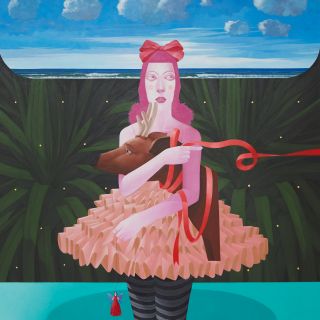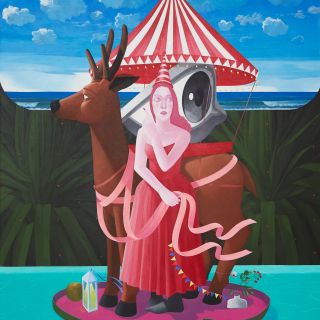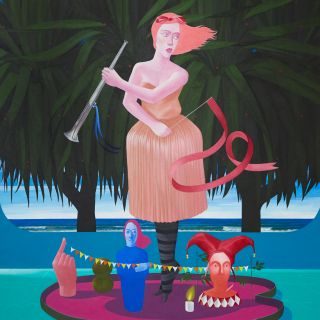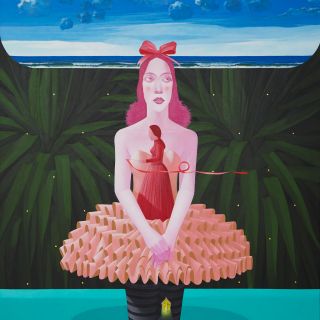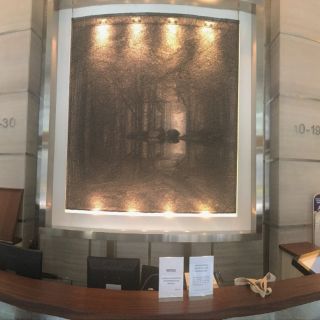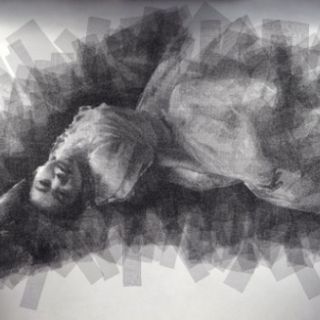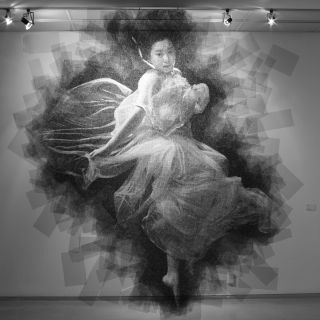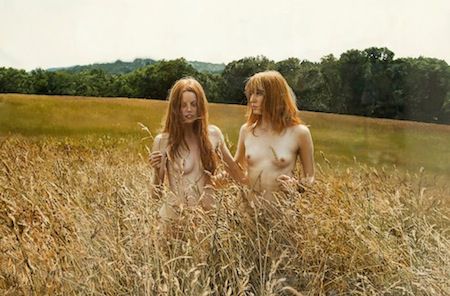
Born in 1958 in Tel Aviv, Israel, New York-based artist Yigal Ozeri takes hyper-realism to the next level. It is hard to believe that his work isn't an actual photograph. Capturing solar flares, dreamy light and contrasting color tones, he shows just how far he is willing to go to capture a moment.
Ozeri's aim as a painter are nothing short of idealistic - in the most reverent sense of the word. To him, the figures and landscapes that he paints capture the spirit of freedom and, aided by technique and process, they seek to express true reality. To help capture authentic human experience, Ozeri does not use professional models only. Instead, he paints social wayfarers and other personalities on the fringes of society that he meets through friends. According to Ozeri, his fascination with the women he paints does not stem from a desire to possess their physical bodies, as much as from a desire to convey their spirit. He spends a long time with his subjects, becoming intimate parts of their lives and even friends of their families, until he is ready to shoot. Though Ozeri directs his crew at every stage of creation, he never directs his models. He describes his method, "I said, 'OK, I'll take the camera, and I'll let you do whatever you want,' and that's how we did it. It was very playful. They did what they wanted, what they felt, and it was great. I used a long lens from far away and took thousands of photographs." Yigal Ozeri has grand intentions for his paintings and for art in general. He sees his work as enacting social change, educating audiences by allowing them to experience the antithesis of death and violence. He wants the world to be a better place and sees art as integral to that process. However, no matter how hard the artist strives in his work to convey a subject outside of historical time and space and "... push through to ... reality" for the wellbeing of humanity, his gorgeous paintings nevertheless exist in a socio-historical context to which they, inevitably, must account.
Yigal Ozeri has exhibited extensively throughout Israel, Europe and the United States, and his work can be found in many prominent collections, including Albertina Museum, Vienna; Hudson Valley Center for Contemporary Art, Westchester; Kennedy Center for the Arts, Washington DC; McNay Art Museum, San Antonio; Nerman Museum, Kansas City; Scheringa Museum of Realist Art, Netherlands; Tel Aviv Museum of Art, Israel; and The Jewish Museum, New York.
Viewing 1 works by Yigal Ozeri
Sort
Biography 
Biography
Born in 1958 in Tel Aviv, Israel, New York-based artist Yigal Ozeri takes hyper-realism to the next level. It is hard to believe that his work isn't an actual photograph. Capturing solar flares, dreamy light and contrasting color tones, he shows just how far he is willing to go to capture a moment. Ozeri's aim as a painter are nothing short of idealistic - in the most reverent sense of the word. To him, the figures and landscapes that he paints capture the spirit of freedom and, aided by technique and process, they seek to express true reality. To help capture authentic human experience, Ozeri does not use professional models only. Instead, he paints social wayfarers and other personalities on the fringes of society that he meets through friends. According to Ozeri, his fascination with the women he paints does not stem from a desire to possess their physical bodies, as much as from a desire to convey their spirit. He spends a long time with his subjects, becoming intimate parts of their lives and even friends of their families, until he is ready to shoot. Though Ozeri directs his crew at every stage of creation, he never directs his models. He describes his method, "I said, 'OK, I'll take the camera, and I'll let you do whatever you want,' and that's how we did it. It was very playful. They did what they wanted, what they felt, and it was great. I used a long lens from far away and took thousands of photographs." Yigal Ozeri has grand intentions for his paintings and for art in general. He sees his work as enacting social change, educating audiences by allowing them to experience the antithesis of death and violence. He wants the world to be a better place and sees art as integral to that process. However, no matter how hard the artist strives in his work to convey a subject outside of historical time and space and "... push through to ... reality" for the wellbeing of humanity, his gorgeous paintings nevertheless exist in a socio-historical context to which they, inevitably, must account. Yigal Ozeri has exhibited extensively throughout Israel, Europe and the United States, and his work can be found in many prominent collections, including Albertina Museum, Vienna; Hudson Valley Center for Contemporary Art, Westchester; Kennedy Center for the Arts, Washington DC; McNay Art Museum, San Antonio; Nerman Museum, Kansas City; Scheringa Museum of Realist Art, Netherlands; Tel Aviv Museum of Art, Israel; and The Jewish Museum, New York.
Collections
Albertina Museum, Vienna, Austria
Beth Rudin DeWoody Collection, New York, NY
Da-Da Yanko Museum, Ein Hod, Israel
Eileen S. Kaminsky Family Foundation, New York, NY
Ein Harod Museum, Ein Harod, Israel
General American Corporation, Houston, TX
Hudson Valley Center for Contemporary Art, Peekskill, NY
Israel Museum, Jerusalem, Israel
The Jewish Museum, New York, NY
Kennedy Center for the Arts, DC
The Krupp Family Foundation, Boston, MA
Kuntzwerien, Wiesbaden, Germany
McNay Art Museum, San Antonio, TX
Museum of Contemporary Art, San Diego, CA
Museum of Modern Art, Haifa, Israel
The Nerman Museum, Kansas City, MO
New York City Public Library, New York, NY
Rema Hort Mann Foundation
The Richard Massey Foundation, New York, NY
Scheringa Museum Voor Realisme, Netherlands
Tel Aviv Museum of Art, Tel Aviv, Israel
Whitney Museum of American Art, New York, NY
Collections
Albertina Museum, Vienna, Austria
Beth Rudin DeWoody Collection, New York, NY
Da-Da Yanko Museum, Ein Hod, Israel
Eileen S. Kaminsky Family Foundation, New York, NY
Ein Harod Museum, Ein Harod, Israel
General American Corporation, Houston, TX
Hudson Valley Center for Contemporary Art, Peekskill, NY
Israel Museum, Jerusalem, Israel
The Jewish Museum, New York, NY
Kennedy Center for the Arts, DC
The Krupp Family Foundation, Boston, MA
Kuntzwerien, Wiesbaden, Germany
McNay Art Museum, San Antonio, TX
Museum of Contemporary Art, San Diego, CA
Museum of Modern Art, Haifa, Israel
The Nerman Museum, Kansas City, MO
New York City Public Library, New York, NY
Rema Hort Mann Foundation
The Richard Massey Foundation, New York, NY
Scheringa Museum Voor Realisme, Netherlands
Tel Aviv Museum of Art, Tel Aviv, Israel
Whitney Museum of American Art, New York, NY
Exhibitions 
Exhibitions
2020
Galerie Edition Rapahel, Frankfurt, Germany
Galerie Ernst Hilger, Vienna, Austria
Flint Institute of Arts, Flint, Michigan
2019
Brandt Gallery, Amsterdam, The Netherlands
Galerie Andreas Binder, Munich, Germany
Pontone Gallery, London, United Kingdom
2018
Louis Meisel Gallery, New York, NY
Art Japan, Tokyo, Japan
Ami Li Gallery, Beijing, China
Imago Galleries, Palm Desert, CA
2017
Ernst Hilger Gallery, Vienna, Austria
Galerie Andreas Binder, Munich, Germany
2013
Territory, Angell Gallery, Toronto, Canada
Triads, Galerie Brandt, Amsterdam, Netherlands
2012
Territory, Mike Weiss Gallery, New York, NY
Photorealism, Galerie de Bellefeuille, Montreal, Canada (Catalogue)
The Boathouse, Galerie Andreas Binder, Munich, Germany
Territory, Karen Jenkins Johnson, San Francisco, CA
Territory, Scott White Contemporary Art, La Jolla, CA
2011
Territory, Martin Asbaek Gallery, Copenhagen, Denmark(Catalogue)
Territory, Zemack Contemporary Art Gallery, Tel Aviv, Israel(Catalogue)
Garden of the Gods, Mike Weiss Gallery, New York, NY(Catalogue)
Luce silenziosa (Silent light), Bologna, Italy (Catalogue)
2010
Lizzie Smoking, Galería Senda, Barcelona, Spain
Lizzie in the Snow, Mark Moore Gallery, Santa Monica, CA(Catalogue)
Desire for Anima, Contemporary by Angela Li, Hong Kong,China
Olga in the Park, Galerie Brandt, Amsterdam,Netherlands
2009
Desire for Anima, Galerie Andreas Binder, Munich, Germany(Catalogue)
The Return of the Horse, Slought Foundation, Philadelphia,PA (Catalogue)
Desire for Anima, Mike Weiss Gallery, New York, NY
Small Death, Galerie Dukan & Hourdequin, Marseille,France, (Catalogue)
Priscilla, Wade Wilson Art, Houston, TX, (Catalogue)
2008
Singer Gallery, Mizel Arts and Culture Center, Denver, CO,(Catalogue)
The Boathouse, Byron Cohen Gallery, Kansas City, MO
Yigal Ozeri, Mike Weiss Gallery, SCOPE Basel 2008,Switzerland
Priscilla in Ecstasy, Charim Galerie, Vienna, Austria
Genesis, Mike Weiss Gallery, New York, NY, (Catalogue)
Genesis, Alon Segev Gallery, Tel Aviv, Israel, (Catalogue)
2007
Priscilla in the Cloud Forest, Mike Weiss Gallery, SCOPEBasel 2007, Switzerland
2006
The Montfort, New Gallery / Thom Andriola, Houston, TX
As Early as New York, Mike Weiss Gallery, New York, NY,(Catalogue)
Long Island City, Musée de Lodève, Lodève, France,(Catalogue)
Café Hawelka, Galerie Eric Dupont, Paris, France
2005
Long Island City, Alon Segev Gallery, Tel Aviv, Israel
New Paintings, Mike Weiss Gallery, New York, NY
Four Seasons, Tel Aviv Museum of Art, Tel Aviv, Israel,(Catalogue)
2004
Long Island City, New Gallery / Thom Andriola, Houston, TX
Long Island City, Galerie Heike Curtze, Berlin, Germany
2003
The Watcher Paintings, Mike Weiss Gallery, New York, NY,(Catalogue)
Memories from The Last Supper, New Gallery / Thom Andriola,Houston, TX
Tableau Vivant, Galerie Heike Curtze, Berlin, Germany
The Last Supper, Galerie Hafemann, Wiesbaden, Germany
2002
The Countess De Castiglione, Galerie Heike Curtze, Vienna,Austria
Presence of the Absent, Stefan Stux Gallery, New York, NY
Presence de L'absence, Galerie Mabel Semmler, Paris, France
Yigal Ozeri: Full Moon, Galerie Heike Curtze, Salzburg,Austria
2001
Tikkun: The Restoration Series, Stefan Stux Gallery, NewYork, NY, (Catalogue)
The Countess De Castiglione, Bineth Gallery, Tel Aviv,Israel, (Catalogue)
The Mark of the Bite, Bineth Gallery, Tel Aviv, Israel, (Catalogue)
Still-Life, Galerie Hafemann, Wiesbaden, Germany,(Catalogue)
Tikkun (Restoration), New Gallery / Thom Andriola, Houston,TX
Galerie Edition Rapahel, Frankfurt, Germany
Galerie Ernst Hilger, Vienna, Austria
Flint Institute of Arts, Flint, Michigan
2019
Brandt Gallery, Amsterdam, The Netherlands
Galerie Andreas Binder, Munich, Germany
Pontone Gallery, London, United Kingdom
2018
Louis Meisel Gallery, New York, NY
Art Japan, Tokyo, Japan
Ami Li Gallery, Beijing, China
Imago Galleries, Palm Desert, CA
2017
Ernst Hilger Gallery, Vienna, Austria
Galerie Andreas Binder, Munich, Germany
Zemack Contemporary Art, Tel-Aviv, Israel
2016
GE Galeria, Mexico
Opera Gallery, Hong Kong
Ernst Hilger Galerie, Vienna
2014
Fiction of Distance, Galería Álvaro Alcázar, Madrid, Spain
Photorealism in the Digital Age, Mana Contemporary, Chicago, Illinois
2016
GE Galeria, Mexico
Opera Gallery, Hong Kong
Ernst Hilger Galerie, Vienna
2014
Fiction of Distance, Galería Álvaro Alcázar, Madrid, Spain
Photorealism in the Digital Age, Mana Contemporary, Chicago, Illinois
2013
Territory, Angell Gallery, Toronto, Canada
Triads, Galerie Brandt, Amsterdam, Netherlands
2012
Territory, Mike Weiss Gallery, New York, NY
Photorealism, Galerie de Bellefeuille, Montreal, Canada (Catalogue)
The Boathouse, Galerie Andreas Binder, Munich, Germany
Territory, Karen Jenkins Johnson, San Francisco, CA
Territory, Scott White Contemporary Art, La Jolla, CA
2011
Territory, Martin Asbaek Gallery, Copenhagen, Denmark(Catalogue)
Territory, Zemack Contemporary Art Gallery, Tel Aviv, Israel(Catalogue)
Garden of the Gods, Mike Weiss Gallery, New York, NY(Catalogue)
Luce silenziosa (Silent light), Bologna, Italy (Catalogue)
2010
Lizzie Smoking, Galería Senda, Barcelona, Spain
Lizzie in the Snow, Mark Moore Gallery, Santa Monica, CA(Catalogue)
Desire for Anima, Contemporary by Angela Li, Hong Kong,China
Olga in the Park, Galerie Brandt, Amsterdam,Netherlands
2009
Desire for Anima, Galerie Andreas Binder, Munich, Germany(Catalogue)
The Return of the Horse, Slought Foundation, Philadelphia,PA (Catalogue)
Desire for Anima, Mike Weiss Gallery, New York, NY
Small Death, Galerie Dukan & Hourdequin, Marseille,France, (Catalogue)
Priscilla, Wade Wilson Art, Houston, TX, (Catalogue)
2008
Singer Gallery, Mizel Arts and Culture Center, Denver, CO,(Catalogue)
The Boathouse, Byron Cohen Gallery, Kansas City, MO
Yigal Ozeri, Mike Weiss Gallery, SCOPE Basel 2008,Switzerland
Priscilla in Ecstasy, Charim Galerie, Vienna, Austria
Genesis, Mike Weiss Gallery, New York, NY, (Catalogue)
Genesis, Alon Segev Gallery, Tel Aviv, Israel, (Catalogue)
2007
Priscilla in the Cloud Forest, Mike Weiss Gallery, SCOPEBasel 2007, Switzerland
2006
The Montfort, New Gallery / Thom Andriola, Houston, TX
As Early as New York, Mike Weiss Gallery, New York, NY,(Catalogue)
Long Island City, Musée de Lodève, Lodève, France,(Catalogue)
Café Hawelka, Galerie Eric Dupont, Paris, France
2005
Long Island City, Alon Segev Gallery, Tel Aviv, Israel
New Paintings, Mike Weiss Gallery, New York, NY
Four Seasons, Tel Aviv Museum of Art, Tel Aviv, Israel,(Catalogue)
2004
Long Island City, New Gallery / Thom Andriola, Houston, TX
Long Island City, Galerie Heike Curtze, Berlin, Germany
2003
The Watcher Paintings, Mike Weiss Gallery, New York, NY,(Catalogue)
Memories from The Last Supper, New Gallery / Thom Andriola,Houston, TX
Tableau Vivant, Galerie Heike Curtze, Berlin, Germany
The Last Supper, Galerie Hafemann, Wiesbaden, Germany
2002
The Countess De Castiglione, Galerie Heike Curtze, Vienna,Austria
Presence of the Absent, Stefan Stux Gallery, New York, NY
Presence de L'absence, Galerie Mabel Semmler, Paris, France
Yigal Ozeri: Full Moon, Galerie Heike Curtze, Salzburg,Austria
2001
Tikkun: The Restoration Series, Stefan Stux Gallery, NewYork, NY, (Catalogue)
The Countess De Castiglione, Bineth Gallery, Tel Aviv,Israel, (Catalogue)
The Mark of the Bite, Bineth Gallery, Tel Aviv, Israel, (Catalogue)
Still-Life, Galerie Hafemann, Wiesbaden, Germany,(Catalogue)
Tikkun (Restoration), New Gallery / Thom Andriola, Houston,TX
Critique 
Critique
A charismatic aspect of both the work and temperament of Yigal Ozeri is his undisguised delight in the power of paint and a robust affection for the painterly surface, proportion and atmosphere. If Damian Hirst dresses up the painter, complete with palette and easel and seals him off in an aquarium as a sign of his obsolescence, Ozeri proves that painting is very much alive. He probes the surfaces of painters he loves, particularly Velasquez and Zubaran, taking fragments of a painting as subjects of his own. He recreates pewter vessels, fruits, baskets, gowns emptied of their wearers, as though by restoring the art of the past to the eyes of the present he can mine the work layer by layer, asking himself questions about the making: Why the great bursts of transparencies in Velasquez? Why is it that faces in his official portraits seem to have received less attention than their gowns? Ozeri turned to the findings and methodologies of restoration to answer these questions. The techniques of restoration reveal things to which the eye has had no entry - it is a science that unfolds art -and the artist's interest lies in the restorer's ability to parse the visual, to lay bare and deconstruct the 'effect' into components of it's making. By going beyond the barrier of optics, he, in fact goes to that place where Velasquez reenacted the self-reflexive act of gazing upon the viewer, when he painted himself painting "Las Meninas." Like Escher's drawings of two hands drawing each other, so Ozeri's art analyzes painting with the tools of painting. He also draws upon the tradition of the Trompe L'oeil paintings of the Dutch Masters. Cornelis Gijsbrechts (late 17th century) was among the first artists conceiving the back of pictures as subject matter; not incidentally, he lived in an era of scientific revolution when great advances were made to divest art of it's sacred reference, and clothe the ordinary in stunning artifice of light and facture of matter.
Ozeri grew interested in the subject of Restoration as a means of penetrating optical consciousness, however, in his latest body of paintings, restoration itself becomes the subject. Images of techniques of restoration are taken directly from technical books and transformed by Yigal Ozeri's very particular form of alchemy into a new investigation of still-life painting. The tools and arena of the restorer: the stretched backs of canvases, the tear awaiting repair and canvas disfigured by a broken frame, turn into a subject that undergoes transformation, through rebirth in paint. The current series is significantly titled, "Tikkun", a Hebrew word that represents, for the artist, healing or restoration. The link between healing and restoration forms an important entry into the works. Whereas both painter and viewer are conventionally concerned with the front of the work, the world of the restorer brings other planes into focus - the scrutiny of the broken, neglected and damaged. "Pandora's Box" reflects rendering of a documentary photograph on the back of a canvas, paneled with wood. A section of the paneling has been removed, to reveal the canvas, which has been defaced by water damage. Ozeri recreates this image with the exactitude of "Trompe L'oeil (although he discounts this term.) Wood, nails and even a patch of what appears to be masking tape, are executed with startling clarity. On the "reverse" of the canvas, at the site of damage, Ozeri has appended painted images, on silk tissue paper, of hanging men after Pissanelo. In other works of this series, the artist has superimposed crystal drinking glasses - overt symbols of healing - while a white glaze that covers the glass is suggestive of the salt residue that marks the passage of shed tears.
"Patch I," the signature painting of the exhibition, shows a restorer's instrument: gauze, stretched over a damaged surface. The painterly "field" on which the gauze is placed - vertical bands of seemingly abstract color, represents a bird's eye view of the restorer's table, the bands representing (from right to left of the painting) the painting awaiting restoration. Its canvas border, the bands, serve a dual purpose: it makes taut the fabric to be restored and also signals the tension of meaning in Ozeri's imagery. These tensions involve the power of illusion in painting and philosophical or theoretical distinctions between real and "artistic"space. Yigal Ozeri, in fact, revisits the auratic aspects of art. The visual concurrence between the Pissanelo quotation of hanging men and Ozeri's painting suspended in the frame, suggests a macabre juxtaposition. The hanged men have shuffled off this mortal coil and passed on to a better world where, hopefully, grace lies ahead. He suspends the picture between two panes of glass, three inches larger than the canvas, attaching it to the casing with invisible fishing line, creating, in his words: "an auratic space around the image." By isolating the painting from the "contaminated" real world and relocating its habitation in the hermetic frame, sealed at the moment of completion, Ozeri restores art to the sacred. The very deliberate attention to the space around, between and behind the work of art, together with the voluptuousness of the subject matter and materials reiterates the return of aura to art in an age which has gone far away from the pictorial - yet another form of 'restoration'. But by situating the image in a Trompe l'oeil vernacular, the artists returns (us) to the 'profane' world, the world of objects, and the familiar.
The Hebrew word "Tikkun" is often used in mystic musings, particularly in Kabalistic discussion on the problems of evil - if God is good, how did evil come to exist? The Kabala answers that creation in not complete, not over, for God made man a partner in creation. It can be completed and the world restored, Tikkun Olam, by acts of righteousness and goodness. Yigal Ozeri makes, in this series of paintings entitled Tikkun, a similar claim for painting. In this complex group of paintings the artist suggests that what you see is not what you get - painting has depths that cannot be comprehended by the eye alone. Ozeri paints the neglected and the broken, restoring beauty, making visible that which was absent and teasing our perception; then finally signaling completion in the act of framing. At the end of it all he insists, with characteristic delight, "it is all illusion and that is the power of painting."
Ozeri grew interested in the subject of Restoration as a means of penetrating optical consciousness, however, in his latest body of paintings, restoration itself becomes the subject. Images of techniques of restoration are taken directly from technical books and transformed by Yigal Ozeri's very particular form of alchemy into a new investigation of still-life painting. The tools and arena of the restorer: the stretched backs of canvases, the tear awaiting repair and canvas disfigured by a broken frame, turn into a subject that undergoes transformation, through rebirth in paint. The current series is significantly titled, "Tikkun", a Hebrew word that represents, for the artist, healing or restoration. The link between healing and restoration forms an important entry into the works. Whereas both painter and viewer are conventionally concerned with the front of the work, the world of the restorer brings other planes into focus - the scrutiny of the broken, neglected and damaged. "Pandora's Box" reflects rendering of a documentary photograph on the back of a canvas, paneled with wood. A section of the paneling has been removed, to reveal the canvas, which has been defaced by water damage. Ozeri recreates this image with the exactitude of "Trompe L'oeil (although he discounts this term.) Wood, nails and even a patch of what appears to be masking tape, are executed with startling clarity. On the "reverse" of the canvas, at the site of damage, Ozeri has appended painted images, on silk tissue paper, of hanging men after Pissanelo. In other works of this series, the artist has superimposed crystal drinking glasses - overt symbols of healing - while a white glaze that covers the glass is suggestive of the salt residue that marks the passage of shed tears.
"Patch I," the signature painting of the exhibition, shows a restorer's instrument: gauze, stretched over a damaged surface. The painterly "field" on which the gauze is placed - vertical bands of seemingly abstract color, represents a bird's eye view of the restorer's table, the bands representing (from right to left of the painting) the painting awaiting restoration. Its canvas border, the bands, serve a dual purpose: it makes taut the fabric to be restored and also signals the tension of meaning in Ozeri's imagery. These tensions involve the power of illusion in painting and philosophical or theoretical distinctions between real and "artistic"space. Yigal Ozeri, in fact, revisits the auratic aspects of art. The visual concurrence between the Pissanelo quotation of hanging men and Ozeri's painting suspended in the frame, suggests a macabre juxtaposition. The hanged men have shuffled off this mortal coil and passed on to a better world where, hopefully, grace lies ahead. He suspends the picture between two panes of glass, three inches larger than the canvas, attaching it to the casing with invisible fishing line, creating, in his words: "an auratic space around the image." By isolating the painting from the "contaminated" real world and relocating its habitation in the hermetic frame, sealed at the moment of completion, Ozeri restores art to the sacred. The very deliberate attention to the space around, between and behind the work of art, together with the voluptuousness of the subject matter and materials reiterates the return of aura to art in an age which has gone far away from the pictorial - yet another form of 'restoration'. But by situating the image in a Trompe l'oeil vernacular, the artists returns (us) to the 'profane' world, the world of objects, and the familiar.
The Hebrew word "Tikkun" is often used in mystic musings, particularly in Kabalistic discussion on the problems of evil - if God is good, how did evil come to exist? The Kabala answers that creation in not complete, not over, for God made man a partner in creation. It can be completed and the world restored, Tikkun Olam, by acts of righteousness and goodness. Yigal Ozeri makes, in this series of paintings entitled Tikkun, a similar claim for painting. In this complex group of paintings the artist suggests that what you see is not what you get - painting has depths that cannot be comprehended by the eye alone. Ozeri paints the neglected and the broken, restoring beauty, making visible that which was absent and teasing our perception; then finally signaling completion in the act of framing. At the end of it all he insists, with characteristic delight, "it is all illusion and that is the power of painting."

Stay connected.
Sign up to our newsletter for updates on new arrivals and exhibitions


